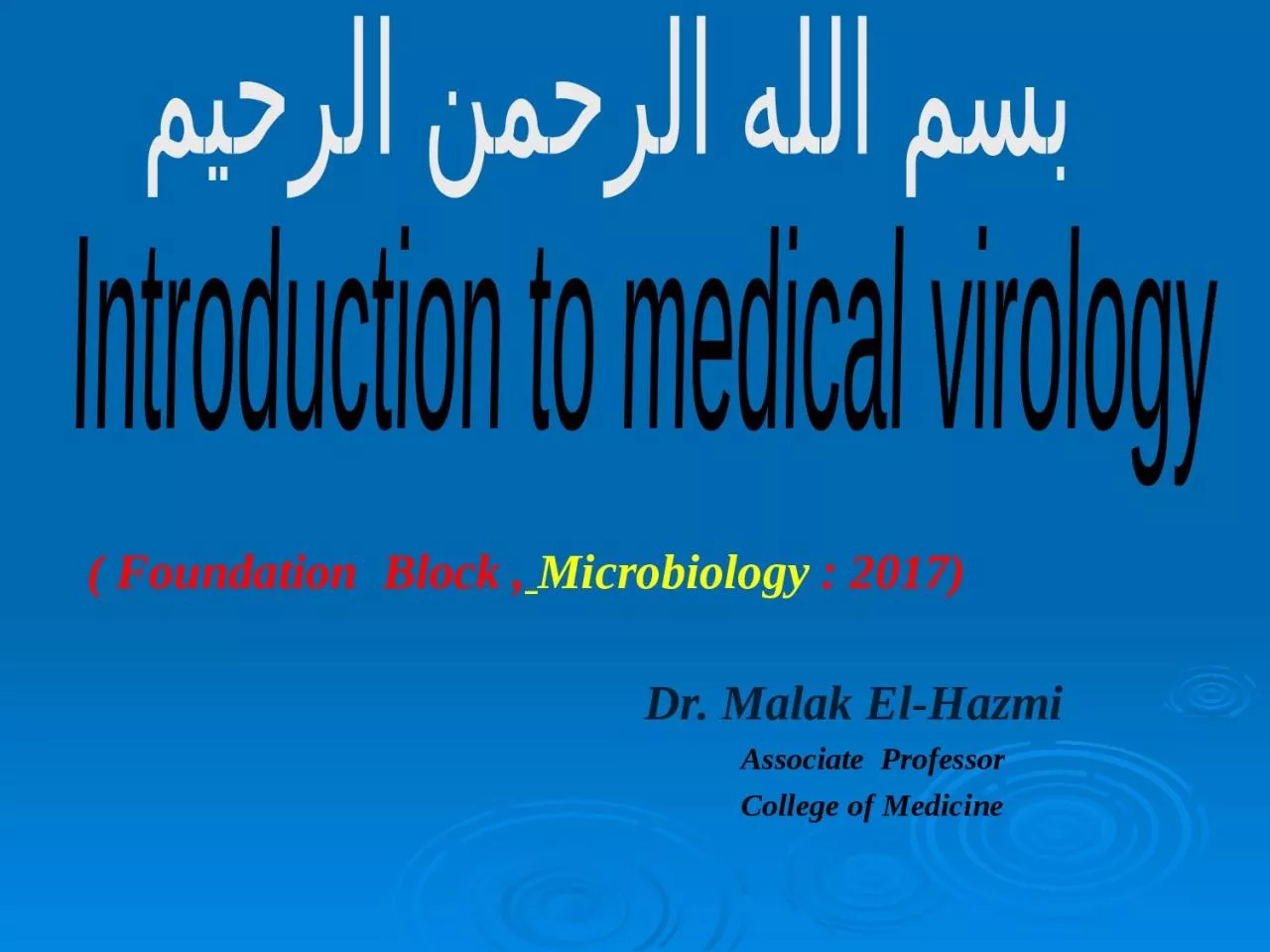

College of Medicine Foundation Block Microbiology 2017 Introduction to medical virology بسم الله الرحمن الرحيم OBJECTIVES Distinguish the viruses from other microorganisms ID: 1038121
Download Presentation The PPT/PDF document "Dr. Malak El- Hazmi Associate Profes..." is the property of its rightful owner. Permission is granted to download and print the materials on this web site for personal, non-commercial use only, and to display it on your personal computer provided you do not modify the materials and that you retain all copyright notices contained in the materials. By downloading content from our website, you accept the terms of this agreement.
1. Dr. Malak El-Hazmi Associate Professor College of Medicine( Foundation Block , Microbiology : 2017) Introduction to medical virology بسم الله الرحمن الرحيم
2. OBJECTIVES Distinguish the viruses from other microorganismsGeneral characteristics of viruses.Structure & symmetry of viruses.Classification of viruses.Steps of virus replication .laboratory diagnosis of viral infections.
3. Properties of MicroorganismscharacteristicParasitesFungi BacteriaVirusesCell YesYesYesNoType of nucleusEukaryoticEukaryoticProkaryotic-----Nucleic acidBoth DNA& RNA Both DNA& RNABoth DNA& RNADNA or RNARibosomesPresentPresentPresentAbsentMitochondriaPresentPresentAbsentAbsentReplicationMitosisBudding ormitosisBinary fissionspecial
4. Characteristics of virusesAcellular organismsTiny particles Internal coreProtein coatSome Vs have lipoprotein mb Obligate intracellular organismsReplicate in a manner diff from cells ( 1V many Vs )
5. Size ; 20-300 nm
6. Viral Structure 1-Viral genome 2-Capsid 3-Envelope
7. Viral Structure1-Viral genome RNA (Ribonucleic acid)All RNA Vs have ss except Reovirusessingle / multiple(+) polarity (-) polarity DNA (Deoxyribonucleic acid)All DNA Vs have ds except ParvovirusesSingle moleculeorAll Vs are haploid ,except retroviruses are diploid
8. Viral structure2-Capsid a protein coat Subunits (capsomeres)Genome (NA) + capsid = nucleocapsidFunction;Protects NAFacilitates its entry into cell
9. Symmetrybased on arrangement of capsomeresCubic symmetry ( Icosahederal ) Helical symmetry Complex symmetry
10. Symmetrybased on arrangement of capsomeres1-Cubic symmetry ( Icosahedral )Adenovirus Herpesvirus
11. Symmetrybased on arrangement of capsomeres2- Helical symmetry3- Complex symmetry poxvirusesElongated (filoviruses)Pleomorphic ( influenza v.)
12. Viral structure3-Envelope Lipoprotein mb(host lipid ,virus specific protein )Budding Envelope is derived from cell mb except herpesviruses from nuclear mbEnveloped Vs are more sensitive to heat ,dry & ether than nonenveloped VsGlycoprotein attaches to host cell receptor
13. Viral proteinsThe outer viral psMediate attachment to specific RsInduce neutralizing AbsTarget of Abs The internal viral psStructural ps ( capsid ps of enveloped Vs )Nonstructural ps ( enzymes)All ssRNA Vs (-) polarity have transcriptase ( RNA dependent RNA polymerase) inside virionsRetroVs & HBV contain reverse transcriptase
14. Classification of virusesType of NA*The no. of strand The polarity of viral genomeThe presence or absence of envelope Type of symmetry
15. Medically Important VirusesComplexPoxviridaeIcosahedral HerpesviridaeHepadnaviridaeIcosahedralAdenoviridaePapillomaviridaePolyomaviridaeEnvelopedRNADNANonenvelopedSingle-strandeddouble-strandedIcosahedralParvoviridaeNonenveloped
16. HelicalOrthomyxoviridaeParamyxoviridaeRhabdoviridaeFiloviridaeBunyaviridaeArenaviridaeHelicalCoronaviridaeIcosahedral Togaviridae Flaviviridae RetroviridaeIcosahedralReoviridaeEnvelopedRNADNANonenvelopedMedically Important Virusesdouble-strandedSingle-strandedNonenvelopedIcosahedralPicornaviridae Hepeviridae Caliciviridae Astroviridae Pos- strandNeg - strandEnveloped
17. Replication Adsorption (Attachment)PenetrationUncoatingSynthesis of viral componentsmRNAViral proteinsNAAssemblyReleaseViral growth cycle
18. Attachment site ; ex- glycoprotein fiber Adsorption
19. Penetration2-EndocytosisViral envelope fuses with endosome mbNonenveloped V. lysis ,pore1-Fusion (enveloped Vs )
20. Replication Adsorption (Attachment)PenetrationUncoating Release of viral genome - cytoplasm - nucleus
21. Synthesis of viral componentsmRNA Viral genome transcription mRNA +ssRNA acts directly Viral proteins mRNA translation viral proteins cell ribosome - enzymes - structural ps replication of viral genome
22. Replication Adsorption (Attachement)PenetrationUncoatingSynthesis of viral componentsmRNAViral proteinsNAAssembly NA + V. proteins = VirionsRelease
23. Release 1-Budding(enveloped Vs)-cell mb*-nuclear mb (herpesVs)2- Cell lysis or rupture (nonenveloped)
24. Replication Adsorption (Attachment)PenetrationUncoatingSynthesis of viral componentsmRNAViral proteinsNAAssemblyReleaseViral growth cycle
25. laboratory diagnosis of viral infectionsMicroscopic examination.Cell culture.Serological tests .Detection of viral Ag.Molecular method .
26. Microscopic examinationLight microscopy; Histological appearance Ex. Inclusion bodies Owl’s eye (CMV)Electron microscopy; Morphology& size of virionsEx. Dx of skin lesion caused by herpesv, poxv. It is replaced by Ag detection & molecular tests
27. Electron micrographs PoxvirusHerpesvirus
28. Virus cultivationLaboratory animalEmbryonated eggCell culture
29. Cell culture
30. Cell culturePrimary C/CDiploid C/C [semi continuous]Continuous cell line
31. Variation in Sensitivity of cell cultures to infection by viruses commonly isolated in clinical virology laboratoriesVirusCell cultureaPMK HDF HEp-2 RNA virus DNA virus Enterovirus Rhinovirus Influenza virus RSV Adenovirus HSV VZV CMV ++++++/-+++++++++-+++++++++++++++++++++--+++-PMK, primary MK. Degree of sensitivity: +++, highly sensitive;++, moderately sensitive; +, low sensitivity; +/-, variable; -, not sensitive
32. Detection of viral growthCytopathic effectsOthersUninfected ccCell roundingSyncytium
33. Problems with cell culture ;Long incubation Sensitivity is variableSusceptible to bacterial contaminationSome Vs do not grow in c/c ex. HCV
34. Rapid culture technique Shell Vial AssayDetect viral antigens1-3 days
35. Serological test;Antigen detection; sample virus testSkin scrapings HSV IFBlood HBV(HBsAg) ELISA
36. Serological test;Ex of techniquesImmunofluorescence (IF)Enzyme- linked immunosorbent assay (ELISA)Antibody detection;
37. Immunofluorescence ; IFA- Direct Ag detection;Sample (Ag)B- Indirect Ab detection;Sample (Ab)
38.
39. ELISAAb detection Ag detection Indirect ELISA for Ab detection ; coloured wells indicate reactivity
40. Molecular test;Polymerase chain reaction (PCR)Amplification tech.Viral genomeUses;DxMonitoring response to Rx
41. Reference books
42.
43. Thank you